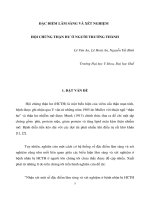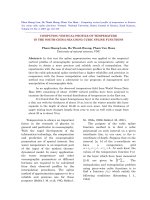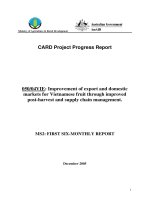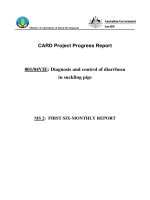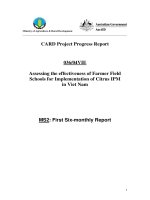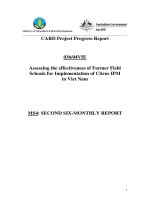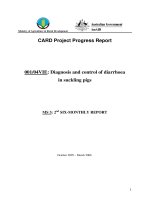Báo cáo nghiên cứu khoa học " Strategy for Distribution of Improved Seed by Research Centre for Forest Tree Improvement (RCFTI), Vietnam " pdf
Bạn đang xem bản rút gọn của tài liệu. Xem và tải ngay bản đầy đủ của tài liệu tại đây (202.22 KB, 19 trang )
22/08/2007
Ministry of Agriculture & Rural Development
Strategy for Distribution of Improved Seed
by
Research Centre for Forest Tree Improvement
(RCFTI), Vietnam
Prepared January 2007
Output from CARD Project No. 058/04VIE
Strengthening Capacity in Forest Tree Seed Technologies Serving Research
and Development Activities and ex-situ Conservation
Disclaimer: The contents and opinions contained in this conceptual framework have been provided in good faith
and on the basis that endeavour has been made to be accurate and not misleading and to exercise reasonable care,
skill and judgment in providing such opinions. Neither Ensis nor any of its employees, contractors, agents or other
persons acting on its behalf or under its control accept any responsibility or liability in respect of use or
exploitation of this conceptual framework by any person.
1. Executive Summary and Recommendations
The Research Centre for Forest Tree Improvement (RCFTI) currently produces 100 kg of
genetically improved tree seed from over 40 seed producing stands (seed orchards or seed
production areas). The seed represents 15 species which are regarded as key species for
commercial and social application in Vietnam and other similar international environments.
Over the next five years RCFTI will become a self supporting research organisation and so the
seed production is predicted excess of 300 kg of improved seed which can make a significant
contribution to the timber industry in Vietnam. In order to achieve this, RCFTI has to develop
its market capability and diffusion capability to distribute the seed and other germplasm
sources it produces together with its range of services.
As part of CARD Project 058/04VIE ‘Strengthening Capacity in Forest Tree Seed
Technologies serving Research and Development activities and ex-situ Conservation’, there is
a requirement to produce two related strategies, one dealing with commercialisation of
RCFTI’s seed sale activities and this document dealing with strategies for distribution of seed.
This document should therefore be read and contents developed in conjunction with the
business strategy titled ‘Concept Paper covering development of a Business Plan for Tree Seed
Supply & Technical Services by the Research Centre for Forest Tree Improvement, Vietnam’.
The successful distribution of better adapted and genetically improved seed by RCFTI relates
to four problem areas. These are: a) lack of awareness and confidence by growers (credibility)
of the benefits of improved seed from RCFTI, b) how to get access to the improved seed, c) the
relatively small quantities of seed produced by RCFTI compared with total demand, and d) the
relatively high cost of RCFTI seed compared with seed from other national sources.
Companies in Vietnam who appreciate the benefit of improved tree seed, often prefer to
purchase seed from international sources with a proven reputation. This is in spite of the fact
that the RCFTI seed may be better adapted and of superior genetic quality, and significantly
cheaper than international sources. By contrast, farmers are after the cheapest possible seed or
seedlings and have to rely on access from local sources. Given RCFTI’s limited distribution
network and higher pricing structure, the centre has not been able to sell direct to farmers.
In order to overcome these challenges and be able to effectively market and distribute its seed,
RCFTI needs to implement a number of initiatives designed to target niche markets where seed
2
quality is important. The following is a summary of recommendations. More detailed
information is provided in Section 6.
Summary of recommendations
It is appreciated that marketing in to the Vietnam tree seed sector is difficult given the lack of
appreciation for genetically improved tree seed in the market place and comparatively limited
amount of seed RCFTI has available making it a minor player in the seed sector. By contrast
RCFTI has been effective in marketing its seed and other products on the international market
where the quality of its products is better understood and valued. In order to enhance the
adoption of genetically improved seed and planting material at the national level there is a need
to:
• Get certificates and registration for genetic seed source (seedling seed orchards, clone seed
orchards and seed production areas), approval of advanced genetically germplasms and
sufficiency for ability of genetic germplasm production and business.
• understand market needs - customers, competition etc.;
• raise the awareness of the value of improved material;
• quantify the value of improved seed;
• determine the demand and supply of major species used in the planting programs, and
• identify the best routes for deployment.
In order to achieve these requirements, RCFTI needs to:
o Speed up getting the certificate and registrations of advanced genetically
germplasms
o Carry out a customer analysis to provide a profile on customer needs and what
goods and services RCFTI can provide. RCFTI needs to develop its brand name so
that it is recognised as the preferred supplier of quality seed. Foster good relations
with existing stakeholders and at the same time develop new business opportunities.
o Gather market intelligence relating to market demand such as species and seed
requirements and how RCFTI’s goods and services are differentiated from
competitors. Develop pricing strategy based on costs, competitor prices and what
the market is prepared to pay.
o Develop promotional material and interaction with clients. This will vary according
to customer base from personal contact with key stakeholders to field
demonstrations for farmers and a wide range of stakeholders.
3
o Develop closer collaboration / partnerships with stakeholders particularly within
MARD. This has the potential to increase market exposure and influence the use of
genetically improved seed as part of a government strategy.
o Continue to develop new improved strains of species and hybrids to meet market
demand. This work should be carried out in parallel with market intelligence. All
new ‘improved seed’ must be vigorously tested against other improved seedlots and
industry standards.
2. Background
Since 1993, large-scale tree planting programs have been carried out in Vietnam. More
recently, the government has initiated a program aimed at establishing an additional 5 million
ha of forest development over the period 1998-2010 through rehabilitation of natural forests
and new plantations. The forest sector including RCFTI through its tree breeding program and
seed supply plays a very important role in these massive planting programs. Key stakeholders
include the Ministry of Agriculture and Rural Development (MARD) through its various
departments and sub-departments at the central and provincial level, forest industries, farmers
and donor agencies.
The average annual planting rate is reported to be 360 000 ha. At least 50% of the planted
forests will utilise exotic species, the majority of which will be acacias and eucalypts, the
species that RCFTI have been focussing on. It is estimated that 470-750 million seedlings will
be planted annually for which 245-370 tonnes of seeds are needed each year to propagate the
required seedlings (MARD 1998).
According to the decision No of 89/2005/QĐ-BNN issued by MARD in December, 2005,
certificate of seed sources must be registered. For using the seed source, all seedling seed
orchards have to be certificated by MARD while seed production areas have to be certificated
by Provincial Department of Agriculture and Rural Development. Therefore, the need to to
initiate, establish seed production sources of good genetic quality and certificate the seed
sources to support the national reforestation programs has been emphasised by MARD.
Government agencies including the Central Forest Seed Company (CFSC), RCFTI and some
provincial research centres are all involved in development of seed production sources (seed
production areas and seed orchards). CFSC has a seed production network of major plantation
4
species totalling 3000 ha. Under Program 327, state forest enterprises in some provenances
were assigned to establish seed production areas of selected species. RCFTI presently has 73.8
ha of seed stands comprising 31 seed production areas and seed orchards across15 species
(Appendix I).
There are a number of issues that need to be addressed by the industry and which affect
RCFTI’s ability to be an effective distributor of seed.
• Collaboration between tree seed stakeholders in Vietnam is generally lacking. There is a
need for a clear division of tasks particularly at the government level (MARD) to minimise
the duplication and competition among stakeholders.
• The genetic and physiological quality of seed and seedlings used in the tree planting
programs is often not satisfactory. There appears to be limited awareness of the real value
of genetically improved seed among seed users, seed producers and decision-makers. Often
good germination is the only attribute considered.
• The price of seed (e.g. seed orchard seeds) and planting material (e.g. acacia hybrid
cuttings) from good sources is much more expensive than that of routine seed. In order to
fulfil the planting target within the available budget, project managers opt to use seed and
planting material from cheap sources.
3. Current tree seed stakeholders in Vietnam
There are many stakeholders involved in the production, supply or use of seed. These
stakeholders can be divided into four main groups:
1) Government agencies under the umbrella of MARD,
2) Forest industries,
3) Farmers, and
4) Donor projects.
MARD and its key forestry departments, institutions and representations at the central,
provincial and district levels are major stakeholders and as such all play a very important role.
In addition, forest industries, farmers, international donors and NGOs are also involved in one
role or another in this sector. The role or responsibility of these stakeholders related to the
5
production, supply and use of seed and planting material. The following information on the
various stakeholders is an update of Pinyopusarerk et al (1999).
MARD
As the ministry in charge of all tree planting programs in Vietnam, MARD is responsible for
development of policy, strategies, guidelines and regulations related to production of seed and
planting material, and to control and monitor their production and utilisation. MARD
Headquarters is located in Hanoi. MARD’s Department of Forestry (DoF) is the executive
office for the 5-million ha Program and in charge of policy, strategy issues and organising and
guiding on:
• Establishment of seed stands and nurseries
• Production and utilisation of seedlings to ensure stable and sufficient supply of quality
seedlings
• Developing appropriate composition of forest plantation, regeneration, enrichment and
thinning
• Export and import of seed and seedlings under government regulations
Another important department of MARD involved in the 5 million ha Program is the National
Centre of Agriculture and Forestry Extension (NCAFE). NCAFE operation extends to
provincial, district and commune levels, and is represented by Agriculture and Forestry
Extension Centre in every province and city. About 70% of the districts have established an
extension station. The main functions of extension are:
• to introduce new agroforestry techniques
• to assist farmers to design and set up demonstration models
• to facilitate exchange of ideas between farmers
• to produce extension material (nursery propagation)
Central Forest Seed Company
The Central Forest Seed Company (CFSC) falls within MARD, and has been the main agency
responsible for production and supply of seed and planting material in Vietnam. CFSC has a
nation-wide mandate and operates through its seven regional seed enterprises which are located
in seven provinces/cities of Hanoi, Lang Son, Vinh Phuc, Quang Binh, Lam Dong, Quy Nhon
and Ho Chi Minh City. Currently 3000 ha of seed sources are registered with CFSC with an
6
estimated production capacity of 400 tonne/year. Most recently CFSC has drafted a national
plan for the production and supply of forest seeds for the 5-million ha Program. CFSC has
several roles as a stakeholder in the seed network:
• Planning of seed demand and supply
• Supply of seed and planting material (seedlings, cuttings, tissue-culture plants)
• Procurement, processing, storage and testing of seed
• Establishment of seed orchards and seed stands (conversion from selected plantations)
• Import and export of seed
• Research, testing and development of new techniques
• Information and extension service
Provincial Departments of Agriculture and Rural Development
In each province or city MARD is represented by a Department of Agriculture and Rural
Development (DARD) which implements MARD’s policy under the authority of the People’s
Committee of the province. The main role of DARD in the seed sector is:
• Development, approval and control of Program 327 and 5-million ha Program within
province
• Control of state forest enterprises (all provinces)
• Control of provincial seed enterprises (some provinces only)
• Control of provincial forest experimental stations/centres and technical sections of
DARD (some provinces only)
• Extension services
Out of the total 61 provinces and cities, 42 are engaged in the production and supply of tree
seed and planting material.
District Agriculture and Forestry Section
At the district level DARD is represented by Agriculture and Forestry Section which
implements MARD’s policy under the authority of the People’s Committee in the district. AFS
manages Program 327 and 5-million ha Program within the district in cooperation with
people’s committee in communes. Their main roles are:
• User of seed and seedlings
• Nursery propagation
7
State Forest Enterprises (SFEs)
SFEs are a major arm of DARD in the plantation forestry development within provinces. There
are currently more than 400 SFEs, with one in most districts. They manage forests totalling
more than 4.5 million ha or 41% of the forest area. The average size of a SFE is 10,000 ha.
Current role of SFEs in the seed sector is:
• Seed production from own seed sources
• Seed supplier
• Production of seedlings and cuttings
• User of seed and seedlings
• Extension service
Forest Research Institutions
MARD’s Department of Science and Technology advises the ministry on research matters and
direct research through the Forest Science Institute of Vietnam (FSIV). FSIV operates through
three research centres and seven divisions based in Hanoi, one sub-institute in Ho Chi Minh
City and eight regional research and production centres located in the provinces of Phu Tho,
Son La, Lam Dong, Vinh Phuc, Dong Nai, Gia Lai, Quang Tri and Ca Mau. FSIV’s Research
Centre for Forest Tree Improvement is a leader in tree improvement research with a long
contact with CSIRO and SAREC through regular exchanges of people, seed, training and
equipment.
Another prominent research institution is the Phu Ninh Forest Research Centre of Paper
Corporation of Vietnam. This Centre has conducted research on species/provenance selection
and established seedling and clonal seed orchards of many commercially important species.
Forest Industries
Forest industries involved in the seed sector are limited to those which invest in plantations for
production of raw material. Most are state-owned or joint ventures.
Vietnam Forest Corporation (Vinafor)
Paper Corporation of Vietnam (formerly Bai Bang Pulp and Paper Mill)
Wood processing association
8
International companies and donors (such as Oji Paper Company, Vijachip/Nissho Iwai, Stora
Enso)
Farmers
With the current government policy to involve active participation of local communities in
forest protection and reforestation, local farmers are now one of the most important players in
the seed supply network. In some communes up to 80% of the people are involved in forestry
activities. Farmers play a very important role in the seed sector today as seed suppliers,
collectors and growers.
9
Table 1. Main functions of stakeholders involved in the seed supply and management network
in Vietnam.
Stakeholder Function
MARD Policy
issues
See
import
Seed
production
Seed
supply
Nursery Technology
transfer
User s
Central departments
x x
Central Forest Seed Company
x x x x x
Provincial DARD
x x x x
District Agri. & Forestry Section
x x
State Forest Enterprises
x x x x x
Forest research institutions
x x x x x
Forest Industries
x x x x
Farmers
x x x
Donor projects
x x x x
10
4. Issues associated with diffusion of genetically improved seed
The successful distribution of genetically improved seed and other germplasm relates mainly to
three problem areas. These are: a) availability of improved germplasm supported by plausible
data; b) access to seed by growers; and c) adoption rate and use.
a. Availability of better-adapted and genetically improved planting material
RCFTI is the key national body in Vietnam for the development of authenticated genetically
improved seed. However, the 100 kg produced currently and anticipated yield of 300 kg by
2010 is an insignificant amount when it is predicted that Vietnam requires 245-370 tonnes of
tree seed per year to meet requirement. However, this should not prevent RCFTI from
establishing niche markets for customers who appreciate the benefits of RCFTI seed.
In agriculture, proven genetically improved seed is well recognised by farmers and there are
grower networks to produce seed of the required strains to meet demand. In forestry, growers
are generally unaware of the benefits of improved seed and the industry is accepting of
unimproved seed of unknown source. Species choice may be the only demand. It is only with
time and field demonstrations that particular clones or strains are recognised as in the case of
the A. mangium x A. auriculiformis hybrids developed by RCFTI which now has national and
international fame.
b) Access to genetically improved seed and planting stock
For agricultural crops, seed supply systems are well advanced and growers are well aware of
the merits of improved strains as a result of their own experiences and from word of mouth
reports. However, such supply systems for tree seed are not developed and there is a lack of
appreciation of the real value of improved tree seed. This is in part because of the difficulty of
providing convincing evidence to growers compared with agricultural crops. Growers often
obtain planting stock rather than seed from various sources. The growers have little control
over the seed source and may in fact not be aware of genetic differences and their potential
impact on yield.
Trees being perennial provide a virtually inexhaustible supply of readily available local cheap
seed. This situation is quite unlike that experienced in agriculture where technically it should
be easier to introduce germplasm of new annual crop varieties and quickly replace older ones.
11
The temptation for nurseries to collect and use any available seed to meet planting deadlines
and customer needs is very real. Several years may pass before the adverse effects become
apparent.
c) Adoption and use of better-adapted and improved plant material
Because of RCFTI’s limited capacity to influence the tree seed sector in Vietnam, only a very
few users are aware of the potential benefit of RCFTI’s tree seed. Part of the constraint is the
lack of extension and education to promote the benefit of the seed and ability to adequately
demonstrate the superiority of seed. Only a few growers are willing to commit funds to the
higher cost of RCFTI seed compared to general market seed. Growers need to be convinced
that RCFTI’s improved tree seed are truly and consistently superior under their conditions and
worth paying the extra money. The local source, which has proven to survive are difficult to
replace with new varieties where comparisons on performance are difficult to show in the field.
To overcome this obstacle, there is a need to demonstrate the benefits of improved seed. The
following is an example of the benefits of using improved E. camaldulensis seed in Thailand.
Unimproved seed produced about 20 cubic metres of round wood/ha/year. With the adoption
of improved seed, a 20% improvement in volume yield was achieved equating to 4 cubic
metres additional yield per ha. This represented a $80/ha/year financial gain.
As is typical of tree growing, a long term strategic approach needs to be taken to establish
suitable demonstration plots as part of research activities which can be used to demonstrate to
growers the benefits. Coupled to this is the need for developing trust with stakeholders so that
they are confident that they can achieve the performance and desired results claimed by
RCFTI.
5. Current procedures at RCFTI for distribution of seed
The seed collected from seedling seed orchards, clonal seed orchards and seed production areas
in several provinces is transported to RCFTI. The seed is cleaned, processed dried, tested for
germination before being stored. Seed information is recorded in the database of seed bank for
further uses. Based on requirements by users, the seed is distributed.
For Acacia and Eucalyptus species, the seed can be stored relatively easily in temporary
conditions provided there is protection against moisture. RCFTI plans to store some seed at
12
other strategically located centres across the country mainly associated with seed sources.
Three main planting centres are planned namely: Ba Vi, Quang Tri and Dong Nai.
6. Recommendation for promoting effective distribution of seed
Customer analysis
RCFTI requires to have a profile on the type and most common type of customers.
Information on customers should include
o Demographics
o Why they want the seed
o When they will buy
o How much they will buy
o How much they will spend and level of price sensitivity
o Communication channels
RCFTI needs to develop its brand name so that it is recognised as the preferred supplier of
quality seed. This will require continuing to foster good relations with existing stakeholders
and at the same time develop new business opportunities
Marketing
In addition to developing its customer base, there are a range of other marketing initiatives
which need to be developed. These include:
• Market research to determine market demand, species requirements, etc. This information
will assist in predicting sales targets and requirements for seed in the coming years to meet
demand.
• Position in the market where RCFTI’s seed, other germplasm and services are in demand.
How are these goods and services differentiated from competitors? What is RCFTI’s
unique selling point?
• Pricing strategy – outline RCFTI’s pricing structure and strategy in relation to competitors,
target market.
• Currently RCFTI sells about 20-30 kg of the improved seed. The seeds were distributed
from RCFTI’s store based on the stakeholder requirement. Through the seed database,
RCFTI has the capacity to generate the necessary documentation associated with seed sales
i.e. quotes, invoices etc.
13
Promoting RCFTI’s seed and services
As part of marketing, development of information and promotional material is an essential part
of promoting seed sales and links to customers. The type of awareness and promotional
initiatives depends on the type of customers. In the case of RCFTI, the market is fairly narrow
and may require person to person contact. However, it is import that RCFTI develop links
with farmers which will require a broader approach to awareness. Such promotional initiatives
should amongst other things defuse the argument about RCFTI seed being ‘too costly’ by
promoting the benefits of good quality seed. ‘Good seed does not cost it pays’.
• Set up some more demonstrations of seed source (genetic gain trials) in the main plantation
areas to demonstrate to growers the differences between seed sources to compare industry
standard seedlots compared with genetically improved sources developed by RCFTI. This
will be a key marketing tool.
• Raise awareness of the value of improved seed;
• Quantify the value of improved seed;
• Amount of seed available by species and adaptability to different environmental zones; and
• Awareness of other products and services
By providing promotional material in response to the above, RCFTI can address issues
surrounding ‘availability of authenticated tree seed and grower access to the seed. As
customers increasing seek to obtain improved seed, RCFTI should find itself in a position
where demand outstrips supply making the concern over RCFTI being a small supplier
irrelevant. With successful use of RCFTI seed and demonstration of benefits, the rate of
adoption and use will hopefully increase further elevating the brand name where RCFTI is
synonymous with quality.
There are various vehicles to promote the seed and services some of which have already been
initiated by RCFTI to include:
• Preparation and distribution of a promotional brochure advertising the goods and services
provided by RCFTI
• Development of species/ seed orchard digests providing basic information on the seed
orchards and incorporating gain trial information to compare improved seed with
unimproved seed. Convert scientific gains into monitory gains.
• Send out regular (annual) fliers to potential customers advertising what stocks are available
and any new improved seed;
14
• Develop the RCFTI web page to promote seed and other goods and services;
• Continue establishment of demonstration and gain trials to support tree improvement work
as a way of demonstrating benefits in the main eco-regions;
• Hold periodic field days and demonstrations for the various stakeholders in order to
promote the benefits.
Development of stakeholder collaboration
There are a number of issues that need to be addressed by the industry which affect RCFTI’s
ability to deliver. Indicatives to include:
• Develop closer collaboration between the various MARD stakeholders to ensure RCFTI is
well placed to benefit from its strategic advantage in having supplies of quality seed and
supporting services. Especially, the collaboration between RCFTI and Central Forest Seed
Company (CFSC) which is a commercial supplier of forest germplasms is considered as the
most important cooperation in this strategy
• Continue to develop with MARD a certification system for all seedlots to identify their
origin and authentication;
• Developed a heightened awareness amongst stakeholders of the benefits of improved seed
to include lobbying government to ensure that the best available genetic material is used for
planting;
Product development
RCFTI needs to continue to produce new improved strains of species and hybrids to meet
market demand. This work should be carried out in parallel with market intelligence. All new
‘improved seed’ must be vigorously tested against other improved seedlots and industry
standards.
Options for physical distribution of seed
Since RCFTI currently only produces about 30 kg of improved seed per year, some of which is
purely for further research of family lines, the centre stores all seed at RCFTI. However, as
seed productions increases there will be opportunity to create storage and distribution centres
linked to RCFTI at other locations depending on species and seed type. For Acacia and
Eucalyptus seeds, the seed can be stored relatively easily in temporary conditions provided
there is protection against moisture. RCFTI plans to store some seed at other strategically
15
16
located centres across the country mainly associated with seed sources. Three main planting
centres are planned namely: Ba Vi, Quang Tri and Dong Nai. RCFTI Ha Noi will co-ordinate
all seed inquiries, distribution and documentation through the seed database tracking system.
References
MARD 1998. Project on production and supply of forest seed for National 5-million
Reforestation Program
K. Pinyopusarerk , Phi Quang Dien and Tran Danh Tuyen 1999. Seed supply and management
network in Vietnam. Report on a preliminary study on seed networks in Vietnam
undertaken as part of a one-year extension (July 1998-June 1999) of The seeds of
Australian trees project (ACIAR FST/1993/118)
Appendix I. List of RCFTI genetically improved seed sources.
Signal
on the
map
Species
Type
of
exp.
Area
(ha)
Planted
Year
Thin
(Yes/N
o)
Predicted
mean
yield/ yr
2010
Organisation/ Centre Location
1 Acacia auriculiformis
SSO 3 1996 Y Experimental Station for Forest Tree Improvement
Ba Vi - Ha Tay
2
CSO 2 2001 N
Eastern South Vietnam Forest Scientific and Production
Centre
Bau Bang - Binh
Duong
3
CSO 2 2002 N Experimental Station for Forest Tree Improvement
Ba Vi - Ha Tay
4
CSO 1.5 2002 N Dong Hoi Forestry Enterprise
Dong Hoi - Quang
Binh
5
SPA 3 1996 Y
North-Central Vietnam Forest Scientific and Production
Centre
Dong Ha - Quang
Tri
6
SPA 3 1994 Y Experimental Station for Forest Tree Improvement
Ba Vi - Ha Tay
7 A. crassicarpa
SSO 4 2002 N Provincal Department of Forestry Development
Phong Dien - Thua
Thien Hue
8
SSO 3 2001 N
North-Central Vietnam Forest Scientific and Production
Centre
Cam Lo - Quang Tri
9
SSO 3 2001 N Binh Thuan Plant Breeding Centre
Ham Thuan Nam -
Binh Thuan
10
SPA 2 1997 Y
North Eastern Vietnam Forest Scientific and Production
Centre
Dai Lai - Vinh Phuc
11 A. mangium
CSO 4 2003 N Cau Hai Sivilcultural and Experimentation Research Centre
Doan Hung - Phu
Tho
12
SSO 2 1996 Y Experimental Station for Forest Tree Improvement
Ba Vi - Ha Tay
13
CSO 2 2001 N
Eastern South Vietnam Forest Scientific and Production
Centre
Bau Bang - Binh
Duong
14
CSO 2 2002 N Dong Hoi Forestry Enterprise
Dong Hoi - Quang
Binh
15
SPA 3 1996 Y
North-Central Vietnam Forest Scientific and Production
Centre
Dong Ha - Quang
Tri
16
SPA 6 1994 Y Experimental Station for Forest Tree Improvement
Ba Vi - Ha Tay
17
Signal
on the
map
Species
Type
of
exp.
Area
(ha)
Planted
Year
Thin
(Yes/N
o)
Predicted
mean
yield/ yr
2010
Organisation/ Centre
Location
Melaleuca
leucadendra
M. cajuputi
17
M. viridiflora
SSO 4 2003 N Minh Hai Wetland Forest Research Centre Kinh Dung - Ca Mau
Melaleuca
leucadendra
M. cajuputi
18
M. viridiflora
SSO 4 2003 N Forest Science Sub-Institute in the South of Vietnam
Long An - Ho Chi
Minh city
19 M. leucadendra
SSO 2 2003 N Experimental Station for Forest Tree Improvement
Ba Vi - Ha Tay
20 M. leucadendra
SSO 2 2004 N Provincal Department of Forestry Development
Phong Dien - Thua
Thien Hue
21 Pinus caribaea
SSO 2 2000 Y Experimental Station for Forest Tree Improvement
Ba Vi - Ha Tay
22
SSO 2 Tropical Forest Centre
Gia Lai
23 P.merkusii
CSO 2 2001 N Dong Hoi Forestry Enterprise
Dong Hoi - Quang
Binh
24
CSO 5 2003 N Experimental Station for Forest Tree Improvement
Ba Vi - Ha Tay
25 P.kesiya
SSO 2 1998 Y
Lam Dong Silvicultural and Experimentation Research
Centre
Lang Hanh - Lam
Dong
26 Eucalyptus pellita
SSO 2 2002 N
Eastern South Vietnam Forest Scientific and Production
Centre
Bau Bang - Binh
Duong
27
SSO 2 2002 N Tropical Forest Centre Pleyku - Gia Lai
28 E. grandis
SSO 1.2 2003 N Tropical Forest Centre
Gia Lai
29
SSO 1.2 2002 N
Lam Dong Silvicultural and Experimentation Research
Centre
Lang Hanh - Lam
Dong
18
Signal
on the
map
Species
Type
of
exp.
Area
(ha)
Planted
Year
Thin
(Yes/N
o)
Predicted
mean
yield/ yr
2010
Organisation/ Centre Location
30 E. urophylla
SSO 3 1996 Y Tam Thanh Foretry Enterprise
Phu Ninh - Vinh
Phuc
31
SSO 3 1997 Y Experimental Station for Forest Tree Improvement
Ba Vi - Ha Tay
32
SPA 3 1997 Y
North-Central Vietnam Forest Scientific and Production
Centre
Dong Ha - Quang
Tri
33
SPA 2.5 1993 Y Experimental Station for Forest Tree Improvement
Ba Vi - Ha Tay
34 E. camaldunensis
SPA 3 1995 Y
North-Central Vietnam Forest Scientific and Production
Centre
Dong Ha - Quang
Tri
35
SSO 5 1996 Y
Eastern South Vietnam Forest Scientific and Production
Centre
Chon Thanh - Binh
Phuoc
36
CSO 1.6 2001 N Binh Thuan Plant Breeding Centre
Ham Thuan Nam -
Binh Thuan
37
CSO 3 1993 Y Experimental Station for Forest Tree Improvement
Ba Vi - Ha Tay
38 E. tereticornis
SSO 3 2001 N The North-Central Centre for Forest Production Science Cam Lo - Quang Tri
39
SSO 3 2001 N Binh Thuan Plant Breeding Centre
Ham Thuan Nam -
Binh Thuan
40
SSO 3 2001 N Phu Yen Plant Breeding Centre
Phu Yen
19
